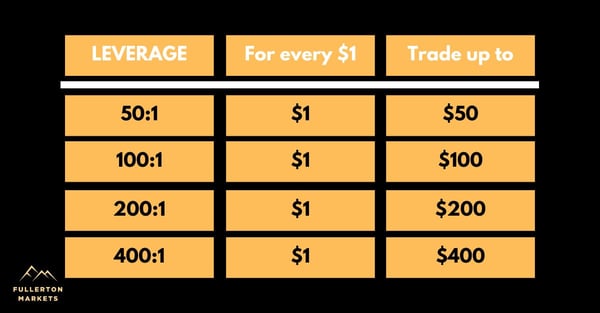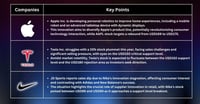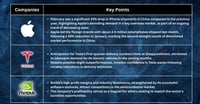Editor’s Note: This post was originally published on January 27, 2017, and has been updated for comprehensiveness.
What is 'Leverage'?

Leverage in Forex Trading
In its purest sense, leverage allows us to do “more with less.”
In the financial world, leverage is used by investors to significantly increase the returns on investment. It is commonly seen as a double-edged sword in trading. It has its fans and its adversaries.
Those in its camp love the fact that large amounts of money can be made with “little money down” while those in the opposing camp lament the fact that leverage always causes accounts to “blow up.” This quickly gives the impression that high leverage is risky.
While many traders have heard of the word leverage, few have a clue about what it really is, how it works, and how it can impact their account. In short, leverage is quite a misunderstood term, especially in the area of Forex trading.
Having said that, let’s delve into the topic a bit more before we draw any conclusions.
How leverage works
Leverage involves borrowing a certain amount of money.
In the world of Forex, that money is usually borrowed from a broker. For instance, when a trader opens up an account with a broker, the amount of leverage provided is either 50:1, 100:1 or 200:1, depending on the broker. Some brokers today even offer leverage of up to 400:1 or 500:1.
Let’s quickly run through the basics to understand the use of leverage a bit more.
When you trade 1 standard lot in Forex, you are trading 100,000 units of the base currency. For example, let’s say that the current price of USD/JPY is 100. This means that USD1 is equivalent to ¥100 at that point in time.
You assess the market and realise that the US dollar is undervalued against the Japanese Yen, which means that you initiate a BUY order in the hope that the price moves up.
Now, to buy 1 standard lot of USD/JPY at the current price of 100, you are actually buying 100,000 units of the US dollar. Most of us do not have that kind of money to initiate the trade! Hence, brokers step in with the perfect solution and offer us the additional capital needed to fund the trade.
Understanding the relationship between leverage and margin trading
How do brokers calculate the maximum amount you can trade based on your capital?
They do this by introducing Margin Trading.
Margin allows a trader to purchase a contract without the need to provide the full value of the contract. Hence, for a $100,000 position (1 lot), on a 1% margin, the trader is required to put down only $1,000.
The leverage provided on a trade like this is 100:1 (100,000/1,000). Here’s the formula:

The Formula of Leverage
So for 1% margin, leverage is 100:1. Hence, a trader can control $100,000 with just a sum of $1,000. For a leverage of 400:1, the trader only needs to put down 0.25% margin. This means that a standard lot of $100,000 can be controlled with only $250.
The table below gives us a quick reference on how margin and leverage co-exist as two peas in a pod:

The Margin Required for Maximum Leverage
What benefits do you gain from using leverage?
Earn more profit for less money and effort
Remember that you just need to put down a small amount to trade by up to 400 times the base capital. A 50:1 leverage, for example, allows you to trade up to $50 for every $1 in your account.

Say you have $500 in your account and you have a 50:1 leverage. You can trade up to $25,000 in the Forex market. If your trade turns a profit, you earn more than the amount you started with.
Increased efficiency in using your capital
How long does it take for you to profit $100 with unleveraged positions? One day? Two days? Three?
When leveraging, you will earn the same amount in less time. This means you can re-invest what you generated from your trade more frequently, earning you a more significant yield overall.
Therefore, from a capital standpoint, you can use it more efficiently with leverage.
Mitigate the effect of low volatility
The greatest degree of profit often comes from volatile trades, but high volatility is not constant in the Forex market. So what happens during low volatility?
You can still profit from small movements using highly leveraged positions. Even when market pricing moves at less significant degrees, leverage enables you to capitalise on them.
What are the risks involved when using leverage?
May translate to heavier losses
While leverage can magnify your profit, it can do the same with your losses. The higher the leverage, the heavier the losses as well.
Take, for instance, Trader A who has a capital of $10,000. Because his risk tolerance is low, he uses the leverage of 1:5, giving him a maximum trade amount of up to $50,000. While trading EUR/USD, he lost 100 pips, which translates to a loss of $500.
Then, there's Trader B who has the same capital as Trader A but with a higher risk appetite. He uses the leverage of 1:50 to trade up to $500,000. He suffers the same fate as Trader A, with a loss amounting to $5,000.
Builds liability that you must meet
At the end of each trading day, the principal amount of leverage must be paid, regardless if a transaction went up or down. It is automatically deducted from your account. So, you're handicapped by default the moment you enter a leveraged position.
Increased risk of a margin call
Brokers often establish margin requirements that traders must meet. If at some point your capital drops below the threshold set by your broker, a margin call is initiated. This can result in your portfolio being liquidated without warning.
But risky doesn’t always mean losing big
Although high leverage gives the impression that the trade is risky, the perceived risk is significantly less when one considers that currency prices usually change by less than 1% during intraday trading. If currencies fluctuated as much as equities, brokers would not be able to provide as much leverage.
What? Now, wait a minute.
I thought Forex has high volatility and that it fluctuates more than equities?
Let me explain.
In Forex, the currency movements are so small on an intraday basis that a new term called 'pips' had to be introduced. A pip is the smallest movement in a currency price. This could be the second or fourth decimal place of a price, depending on the currency pair.
However, these movements are really just fractions of a cent. For example, when a currency pair like the EUR/USD moves 100 pips from 1.5100 to 1.5000, it is just 1 cent (or $0.01) of the exchange rate.
Here’s an example to drive home the point. The price of EUR/USD went from 1.0979 to 1.0586 from 1st November to 1st December, a period of high volatility due to the closely contended US presidential election.
Now, as volatile as the movements were, it was only a movement of 400 pips or a mere 4 cents. Would you trade a stock that moved just 4 cents in 1 month?
So you see, the reason brokers can afford to give high leverage in the Forex market is because intraday movements in the market are minute.
This is why currency transactions must be carried out in big amounts, allowing these minute price movements to be translated into decent profits when magnified through the use of leverage. It is the provision of leverage that allows traders to earn significant profits in the market.
However, leverage can also work against investors. For example, if the currency moves in the opposite direction of what a trader believed would happen, leverage would greatly amplify the potential loss. To avoid such a catastrophe, Forex traders usually implement a strict trading style that includes the use of a stop-loss.
Can leverage blow up your trading account?
Now that we understand the definition and utilisation of leverage, how do we deal with the fact that leverage can “kill” a trader’s account?
In reality, the issue isn’t leverage, it’s poor risk management. High leverage only reduces the amount of capital required to initiate a position. Great traders know that they will never risk more than 3% of their capital on any trade. Your job is to employ sound Forex risk management by not risking more than 3% of your capital on any one trade.
As an example, if you start with a capital of USD10,000 then a 3% risk means that you will not lose more than USD300 of your account on that trade. Hence, it really doesn’t matter if you trade with 100:1 leverage or 500:1 leverage. It wouldn’t be any “riskier” if you used higher leverage provided you used proper risk management.
This involves planning your entry point, profit target, and stop-loss before placing a trade. Your lot size is then calculated accordingly so that you never risk more than 3% of your capital on the trade.
Learn How to Better Overcome [or Mitigate] Forex Trading Risks and Profit More
The point is that leverage is not the enemy. If you plan your trade so that you are risking a small amount of capital on each trade, very high leverage will not have a negative effect.
On the contrary, low leverage can severely hamper a trader’s potential for profit because the trader may not have enough capital to enter a full position and/or multiple positions at the same time.
On a 10:1 leverage, a trader would have to put down $10,000 to initiate 1 lot as opposed to just $1,000 had he employed a 100:1 leverage.
What leverage should you use?
Most professional traders agree that a 1:100 to 1:200 leverage provides a balance between a trader's buying power and risk. This makes it the best leverage for trading Forex.
But leveraging is a personal choice. You can stick with the standard or identify which ratio works best for you.
Either way, the leverage you choose is best based on three main factors:
- Risk appetite
- Strategy or timeframe
- Experience
If you have a low-risk appetite, have yet to establish a reliable strategy, and have little trading experience, you should use low leverage.
Beginners are advised to use no more than 1:20 to better protect their portfolio. In fact, this is a good way for new traders to survive potential pitfalls of leveraging.
Once they've improved on all three factors, they can then increase their leverage.
Regardless if you're a beginner or expert Forex trader, however, leverage will be more beneficial if you:
- Follow and stick with your risk management rules
- Avoid abusing free margin
- Maintain a reserve of funds that will allow you to close open positions by stop-loss order, effectively protecting active trades from early liquidation.
Key takeaway
In summary, leverage is a good thing. It is there to help you. Leverage is an imperative tool that all successful traders use to grow their account consistently. Now shouldn’t we do the same?
To quote Archimedes, 220BC, “Give me a lever long enough and a fulcrum on which to place it, and I shall move the world."

Ready to build and grow your wealth in the world's largest financial market? No better place to start than right here with us! Begin trading with Fullerton Markets today by opening an account:
You might be interested in: Types of Traders: How to Choose Your Trading Style














